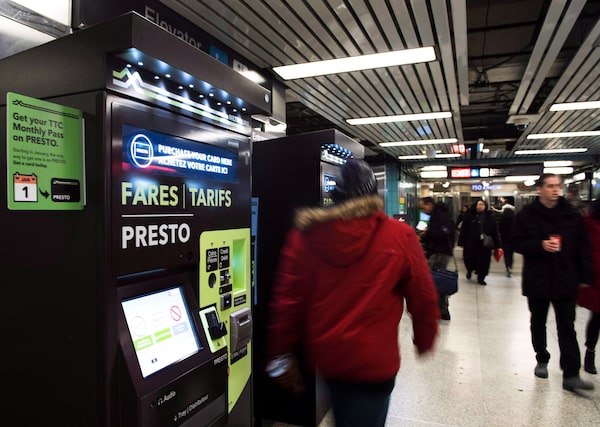
People walk past Presto machines at a TTC subway station in Toronto on Dec. 4, 2018.Nathan Denette/CP
Torontonians are fuming. A city that happily accepts human beings living in tents under the Gardiner Expressway is aflutter about fare cheats on the Toronto Transit Commission (TTC). The controversy has created two camps: those who want to go Hunger Games on fare evaders and those who believe the TTC should be free – or, at the very least, more affordable.
The TTC, which says fare scofflaws cost it over $70-million last year, is firmly in the former camp.
And so, the agency is implementing a “Revenue Protection Strategy Deployment” based on findings from a six-week study of fare evasion conducted by the Audit, Risk and Compliance (ARC) Department and Transit Enforcement Unit. Their study showed that a third of fare evaders are adult riders who fraudulently use child PRESTO cards. The TTC plans to have 111 fare inspectors and 72 special constables patrolling the system by the fall; some in plain clothes. The TTC maintains such measures will save them $10.2-million and intends to spend $3-million of the savings on 50 more constables, leaving a net savings of $7-million.
They’ve currently rolled out a public relations campaign to discourage fare evasion. Riders are now greeted with enormous slogans such as “No Big Deal” and “Probably won’t get caught!”
It’s easy to paint fare evaders as devious robbers, but even the TTC admits “changes implemented by the TTC since 2010 to improve operational efficiencies, modernize the customer experience and enhance access through fare-policy changes have inadvertently increased fare-evasion risk.” In other words, people try to pay at the newfangled PRESTO machines, but those frequently malfunction – not unlike the TTC itself. Riders who want to pay can’t. That’s not exactly evil-mastermind territory.
Basic physics accounts for other incidents. Previously, streetcar riders entered at the front, where they paid their fare. Now, they can enter anywhere. The Audit and Risk Management Committee’s recent Fare Evasion Study report found that “the streetcar network experiences the highest rate of fare evasion at 15.9 per cent.” Enter the fare inspectors.
Some take a different approach. Londoners discovered that their New Routemaster buses, which allowed boarding through all doors, increased fare evasion. They solved the problem by making the middle and back doors exit-only.
As the Road Sage columnist, I’ve a unique perspective on the issue, and I believe the trouble with single-mindedly going after fare evasion is that it misses the real problem behind Toronto’s transit woes. Put simply: The TTC doesn’t reflect the city’s true character. For starters, almost everyone pays the same fees. That just ain’t Toronto.
Toronto is real estate. It exists so that a city of developers by developers for developers shall not perish from the earth. If the people who ran Toronto ran Rome, all that would be left of the Colosseum would be a single set of arches with a giant condo stuck on the back. It’s about having – and stepping over those who have not.
In order to truly mirror Toronto’s nature, the TTC needs to adopt a class system.
There should be first-class trains for those with money. Let’s call them “landowners.” They would feature roomy seats, bottled water, free WiFi and valet service. The city’s affluent can pay extra for this service, just as they do when they fly. It could be given a snappy name such as Commuter Plus or TTC Max.
Next, there would be a second class. Essentially, the same service that the TTC offers now, and it would have a name like Compliant Traveller. Finally, we would have a very cheap third class. These subway trains, streetcars and buses would be unheated and stripped of seating, similar to the sort of vehicles used to transport livestock to the abattoir. These would be patrolled by constables armed with batons and pepper spray. Think: TTC Indentured.
Indentured is the appropriate moniker because, like indentured servants in the 18th century, so many struggling to live in Toronto have their lives defined by what they owe.
They pay exorbitant rent. They pay credit-card interest rates so high that if you tried to charge them during the 14th century, an angry mob would have burned you at the stake. They have bloated student loans. They spend their lives trying to escape debt. But unlike the indentured of the 18th century, who received housing and food in exchange for their labour, today’s indentured must pay for such things as well.
Hey, it may sound far-fetched, but in a city that is in catatonic denial about frequent pedestrian traffic fatalities but wets the bed over fare evasion and Chair Girl, maybe a TTC class system would actually solve its financial woes.
Then again, it might help on a philosophical level if the TTC stopped referring to riders as customers and started calling them citizens.
A customer pays their fee and gets taken for a ride.
Citizens have a right to freedom of movement. Citizens have a claim and stake in the city they call home. Citizens deserve an affordable public transit system. Law-abiding citizens should not to be hectored by slogans and spied on by plainclothes constables.
Until that day – Friends. Torontonians. Countrymen. Give me your fares.
Shopping for a new car? Check out the Globe Drive Build and Price Tool to see the latest discounts, rebates and rates on new cars, trucks and SUVs. Click here to get your price.
Stay on top of all our Drive stories. We have a Drive newsletter covering car reviews, innovative new cars and the ups and downs of everyday driving. Sign up for the weekly Drive newsletter, delivered to your inbox for free. Follow us on Instagram, @globedrive.
 Andrew Clark
Andrew Clark